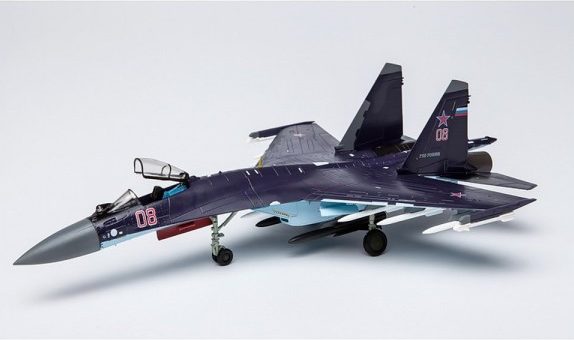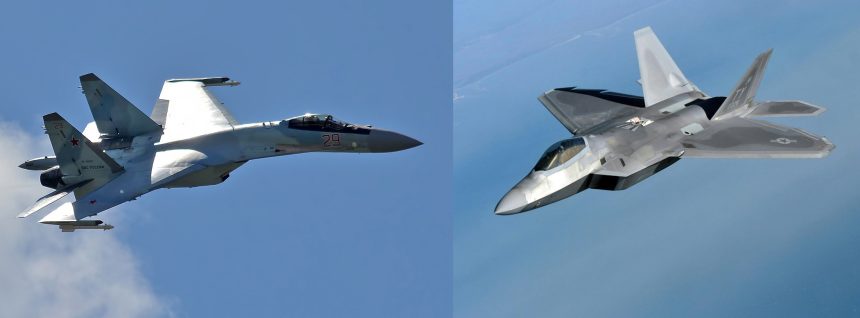A close encounter between an F-22, two Su-25s and one Su-35S occurred over Syria some weeks ago. Many things about the incident are yet to be explained though. CENTCOM: “There is no truth to this allegation.”
Several Russian media outlets are reporting an incident that involved a U.S. F-22 and some Russian aircraft over Syria, to the west of the Euphrates on Nov. 23, 2017. Some details of the close encounter were unveiled by the Russian MoD’s spokesman, Major General Igor Konashenkov, who described the episode “as yet another example of US aircraft attempts to prevent Russian forces from carrying out strikes against Islamic State,” according to RT.
According to the Russian account, a Russian Su-35S was scrambled after a U.S. F-22 interfered with two Su-25s that were bombing an Islamic State target. Here’s Sputnik news version:
“An American F-22 fighter actively prevented the Russian pair of Su-25 attack aircraft from carrying out a combat mission to destroy the Daesh stronghold in the suburbs of the city of Mayadin in the airspace over the western bank of the Euphrates River on November 23. The F-22 aircraft fired off heat flares and released brake shields with permanent maneuvering, imitating an air battle.”
At the same time, he [Major-General Igor Konashenkov, the Russian Defense Ministry’s spokesperson] noted that “after the appearance of a Russian multifunctional super maneuverable Su-35S fighter, the American fighter stopped dangerous maneuvers and hurried to move into Iraqi airspace.”
Many things are yet to be explained making the story really hard to believe:
- it’s not clear why the F-22 was flying alone (most probably another Raptor was nearby);
- why did the stealth jet release flares and perform hard maneuvering (lacking a direct radio contact, was the American pilot trying to catch the Russian pilots attention using unconventional signalling)?
- was the F-22 mission a “show of force”?
- what are the RoE (Rules Of Engagement) in place over Syria?
- were there other coalition aircraft nearby? Where? Did they take part in the action?
- how was a Su-35 scrambled from Hmeymim airbase able to chase away the F-22? Did the Flanker reach the area in time to persuade the Raptor to leave?
Update Dec. 10, 06:53 GMT: we have just received an email from CENTCOM CJTF OIR PAO with their version of the alleged incident that denies and debunks the Russian MoD claims:
There is no truth to this allegation. According to our flight logs for Nov 23, 2017, this alleged incident did not take place, nor has there been any instance where a Coalition aircraft crossed the river without first deconflicting with the Russians via the deconfliction phone line set up for this purpose. Of note, on Nov 23, 2017, there were approximately nine instances where Russian fighter aircraft crossed to the east side of the Euphrates River into Coalition airspace without first using the deconfliction phone. This random and unprofessional activity placed Coalition and Russian aircrew at risk, as well as jeopardizing Coalition ability to support partner ground forces in the area.
Any claims that the Coalition would protect Daesh, or hinder, a strike against Daesh are completely false. We strike them hard wherever they are found. What we can tell you is that we actively deconflict the airspace in Syria with the Russians to ensure the enduring defeat of Daesh in the region. We will continue to work with our SDF partners, just as we will continue to deconflict with the Russians for future Coalition strikes against Daesh targets in Syria.
Anyway, the (alleged) episode reminds the incident that occurred on Jun. 18, 2017, when an F/A-18E Super Hornet belonging to the VFA-87 “Golden Warriors” and piloted by Lt. Cmdr. Michael “Mob” Tremel,” shot down a Syrian Arab Air Force Su-22 Fitter near the town of Resafa (40 km to the southwest of Raqqa, Syria), after the pro-Assad Syrian Air Force ground attack aircraft had bombed Coalition-friendly SDF positions. In the official statement released from the Coalition about the incident the Combined Joint Task Force stated, “The Coalition’s mission is to defeat ISIS in Iraq and Syria. The Coalition does not seek to fight the Syrian regime, Russian, or pro-regime forces partnered with them, but will not hesitate to defend Coalition partner forces from any threat.”
If confirmed, the one on Nov. 23 would be the first “official” close encounter between F-22 and the Su-35 over Syria.
The Su-35 is a 4++ generation aircraft characterized by supermaneuverability. Although it’s not stealth, it is equipped with a Irbis-E PESA (Passive Electronically-Scanned Array) and a long-range IRST – Infrared Search and Tracking – system capable, (according to Russian sources…) to detect stealth planes like the F-35 at a distance of over 90 kilometers.
The Su-35S was deployed at Hmeymim airbase, near Latakia in Syria at the beginning of 2016, to provide cover to the Russian warplanes conducting raids in Syria in the aftermath of the downing of a Su-24 Fencer by a Turkish Air Force F-16. During the Syrian air war the aircraft carried Vympel R-77 medium range, active radar homing air-to-air missile system (a weapon that can be considered the Russian counterpart of the American AIM-120 AMRAAM) along with R-27T (AA-10 Alamo-B), IR-guided air-to-air missiles.
Shortly after being deployed to Syria the Su-35S started shadowing US-led coalition aircraft: a German Air Force spokesperson explained that the Russian Flankers were among the aircraft used by the Russian Air Force to shadow the GAF Tornado jets carrying out reconnaissance missions against ISIS; a VFA-131 video that included footage from the cruise aboard USS Eisenhower in support of Operation Inherent Resolve, in Syria and Iraq showed a close encounter with what looked like a Su-35S Flanker-E filmed by the Hornet’s AN/ASQ-228 Advanced Targeting Forward-Looking Infrared (ATFLIR) pod.
Aviation analysts have long debated the tactical value of the Russian Su-35S supermaneuverability displayed at airshows in the real world air combat environment. Are such low speed maneuvers worthless to fight against the U.S. 5th Gen. stealth aircraft, such as the F-22, that would engage the Su-35S from BVR (Beyond Visual Range) exploiting their radar-evading capabilities?
It depends on several factors.
The F-22 is a supermaneuverable stealth aircraft. Raptor’s stealthiness is maintained by storing weapons in internal bays capable to accommodate 2x AIM-9 Sidewinder missiles, some AIM-120C AMRAAM air-to-air missiles (the number depending on the configuration), as well as 2x 1,000 pound GBU-32 JDAM or 8x GBU-39 small diameter bombs: in this way the Raptor can dominate the airspace above the battlefield while performing its mission, be it air superiority, OCA (Offensive Counter Air), or the so-called kinetic situational awareness “provider”. Moreover its two powerful Pratt & Whitney F-119-PW-100 engines give the fifth fighter the ability to accelerate past the speed of sound without using the afterburners (the so-called supercruise) and TV (Thrust Vectoring), that can be extremely useful, in certain conditions, to put the Raptor in the proper position to score a kill.
All these capabilities have made the F-22 almost invincible (at least on paper and mock engagements). Indeed, a single Raptor during one of its first training sorties was able to kill eight F-15s in a mock air-to-air engagement, well before they could see it.
In its first Red Flag participation, in February 2007, the Raptor was able to establish air dominance rapidly and with no losses. As reported by Dave Allport and Jon Lake in a story which appeared on Air Force Monthly magazine, during an Operational Readiness Inspection (ORI) in 2008, the F-22s scored 221 simulated kills without a single loss!
Still, when outnumbered and threatened by F-15s, F-16s and F-18s, in a simulated WVR (Within Visual Range) dogfight with particularly limiting ROE, the F-22 is not invincible. For instance, during the 2012 Red Flag-Alaska, the German Eurofighters not only held their own, but reportedly achieved several kills on the Raptors.
Even though we don’t know anything about the ROE set for those training sorties and, at the same time, the outcome of those mock air-to-air combat is still much debated (as there are different accounts of those simulated battles), the “F-22 vs 4th Gen aircraft” is always a much debated topic.
In fact, although these 4th Gen. aircraft are not stealth, they are equipped with IRST (Infra-Red Search and Track).
Indeed, F-22s and other stealth planes have extremely little radar cross-section (RCS) but they do have an IR signature. This means that they can be vulnerable to non-stealthy planes that, using their IRST sensors, hi-speed computers and interferometry, can geo-locate enemy LO (low observability) aircraft.
Indeed, there are certain scenarios and ROE where IRST and other tactics could greatly reduce the advantage provided by radar invisibility and this is one of the reasons why USAF has fielded IRST pods to Aggressors F-16s in the latest Red Flags as proved by shots of the Nellis’s Vipers carrying the Lockheed Martin’s AN/AAS-42. According to some pilots who have fought against the F-22 in mock air combat, the IRST can be extremely useful to detect “large and hot stealth targets like the F-22″ during mock aerial engagements at distances up to 50 km.
That said, the F-22s remains the world’s most advanced air superiority aircraft and would be able to keep an edge on an Su-35S at BVR (Beyond Visual Range): even though AAMs (Air-to-Air Missiles) are still somehow unreliable and jamming is sometimes extremely effective, the U.S. stealth jets (as well as the F-15s and F/A-18s operating over Syria) rely on a superior intelligence and tightly integrated one another. This means that the F-22s would be able to arrange the engagement based on a perfect knowledge of the battlefield; a true “information superiority” that is probably more important than the aircraft’s peculiar features. However, if forced to closer range (within range of the IRST) to comply with limiting ROE or for any other reason, the F-22 would find in the Russian Su-35S a fearsome opponent, and would have to rely mainly on the pilot’s experience and training to win in the aerial engagement against Moscow’s top supermaneuverable combat aircraft.
Top image:










